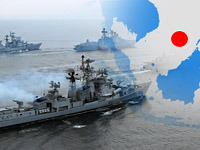India and USA to protect Vietnam from China
 Vietnam is not alone in a festering territorial dispute with China. In the near future Indian warships will arrive into the South China Sea. This is a group of destroyers CMD (controlled missile defense).
Vietnam is not alone in a festering territorial dispute with China. In the near future Indian warships will arrive into the South China Sea. This is a group of destroyers CMD (controlled missile defense).

But there is more to it: at the end of June there were reports from New Delhi that the Indian Navy intends to settle in the South China Sea for a long time. The Indian side is expected to establish a permanent military presence there.
According to the official government version of India, this will help the Navy of India to play a more prominent role in South-East Asia where strategic shipping lines are located.
By doing this, India, as one of the major competitors of China in the region, intends to prevent the far-reaching plans of China to expand its sphere of influence. It is no secret that China intends to establish full control over all the islands in the South China Sea.
At the moment, it controls the Paracel Islands seized in 1974 from South Vietnam, as well as a smaller part of the Spratly archipelago. The severity of the dispute is explained not only by the importance of shipping lanes from the Pacific into the Indian Ocean, but also the wealth of biological resources of the South China Sea and, most importantly, large deposits of hydrocarbons on the shelf.
In particular, the Vietnamese side provides the entry for the Indian warships and naval bases in Nhatraneg and Halong Bay. In addition, India offers aid to Vietnam to increase its naval power by building ships and training of Vietnamese sailors.
Also read: Russia returns to China
Hanoi is not able to withstand the Chinese pressure at sea. This is clearly demonstrated by the events of 1988 when the Chinese were able to capture the Spratly archipelago and win a landslide victory in the clash with Vietnamese Navy.
Since then, the gap between the Chinese and the Vietnamese Navy has increased many times not in favor of the latter. Several years ago, Vietnam's leadership took steps to reduce it. In particular, they purchased six diesel submarines from Russia. Nevertheless, their presence could not stop the Chinese who have much more powerful navy.
In the last six months, they have been actively demonstrating their muscles not only to the Vietnamese but also Filipinos who are also claiming a part of the Spratly archipelago. The severity of the territorial dispute has reached such a high level that Manila recently asked Washington to interfere, and tried to develop a united front with Vietnam to cope with the "China threat."
However, the Chinese Navy is decisively superior to the battle fleets of Vietnam and the Philippines combined, and in the event of military conflict the chances of Manila and Hanoi at sea are minimal.
Recently, the likelihood of this scenario has markedly increased. In late May, the tension between China - Vietnam and China - the Philippines has increased dramatically. The parties sent additional Navy forces to the problem areas. Vietnamese Prime Minister Nguyen Tan Dung on June 14 issued a decree in this regard on conscription of sailors in the event of further escalation of the conflict with China.
The latter, based on the balance of power, is clearly not afraid and shows determination and full control over the Spratly archipelago. An additional impetus is given by high world prices on hydrocarbons, on the one hand, and the lack of progress in Chinese-Russian negotiations on gas prices, on the other.
However, the establishment of China's full control over the islands of the South China Sea has created enormous problems for the countries of South and Southeast Asia. Even in Indonesia, not to mention Malaysia and the Philippines, there are growing fears that China might use the Spratly as a springboard to leap into the South Seas countries.
As for India, there is another reason why the growing Chinese expansion in the region has caused such a strong opposition. Recently its opponent Pakistan decided to give the Chinese a naval base on its shores. In case of further strengthening of China in the South China Sea, India is risking to be extremely disadvantaged in terms of strategic position.
However, speaking of the commotion caused by the Chinese activity, we should not forget about "the singer behind the scenes." The United States plays a significant role in building the anti-Chinese alliance with India.
Since December of 2007 the influential American officials, including the chief of the CIA, have been paying regular visits to Vietnam. In the face of rising threats from the Chinese, the parties are demonstrating their intent to forget past grievances. This once again emphasizes that despite the anticipated military demonstrations in India the U.S. warships will arrive to the Vietnamese coast in the near future.
They will not limit themselves with "courtesy calls" and will conduct trainings with the Vietnamese Navy. Of course, it has already provoked a nervous reaction in China that urged the U.S. to "not interfere in the territorial disputes in the South China Sea." Yet, this outcry is unlikely to scare the Americans who will be increasing their activity in the region as China's activities are enhancing. Otherwise they will lose the strategically important in terms of geopolitics territory to the Chinese.
Sergey Balmasov
Pravda.Ru
Subscribe to Pravda.Ru Telegram channel, Facebook, RSS!


